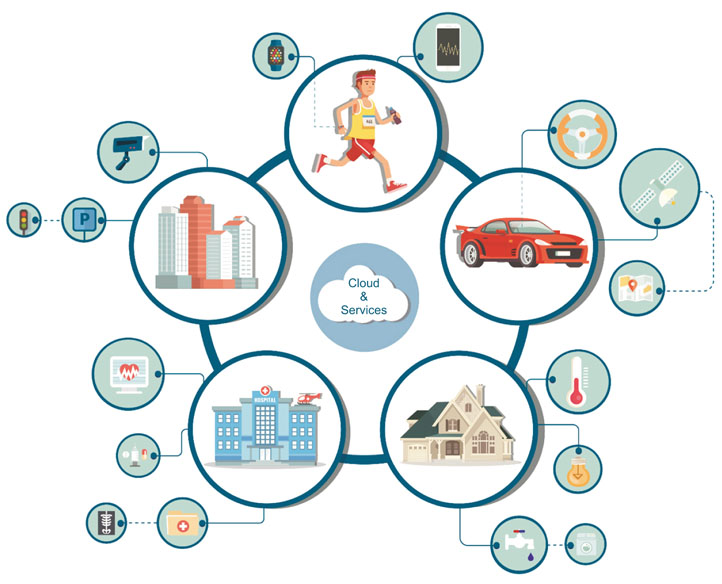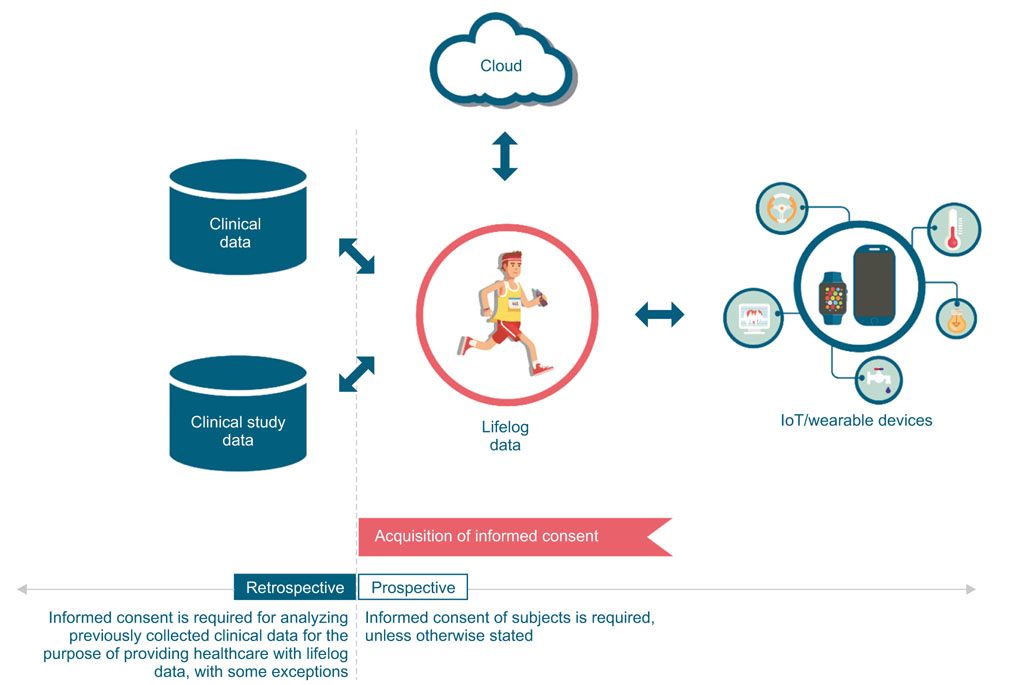Healthc Inform Res.
2018 Jan;24(1):3-11. 10.4258/hir.2018.24.1.3.
Enchanted Life Space: Adding Value to Smart Health by Integrating Human Desires
- Affiliations
-
- 1Health Innovation Big Data Center, Asan Institute for Life Science, Asan Medical Center, Seoul, Korea.
- 2Department of Biomedical Informatics, Asan Medical Center, Seoul, Korea. rufiji@gmail.com
- 3Department of Convergence Medicine, Asan Institute for Life Science, Asan Medical Center, Seoul, Korea.
- 4Clinical Research Center, Asan Institute for Life Science, Asan Medical Center, Seoul, Korea.
- 5Human Research Protection Center, Asan Institute for Life Science, Asan Medical Center, Seoul, Korea.
- 6Medical Information Office, Asan Medical Center, Seoul, Korea.
- 7Department of Cardiology, Asan Medical Center, University of Ulsan College of Medicine, Seoul, Korea.
- 8Department of Emergency Medicine, Asan Medical Center, University of Ulsan College of Medicine, Seoul, Korea.
- KMID: 2403290
- DOI: http://doi.org/10.4258/hir.2018.24.1.3
Abstract
OBJECTIVES
Developments in advanced technology have unlocked an era of smart health, transforming healthcare practices inside and outside hospitals for both medical staff and patients. It is now possible for patients to collect detailed health data using smartphones and wearable devices, regardless of their physical location or time zone. The use of these patient-generated data holds great promise for future healthcare advancements in many ways; however, current strategies for smart-health technologies tend to focus on the smartness of the technology itself and on managing a particular disease or condition. Moreover, opportunities for people within the healthcare system to experience the benefits of these innovations are still limited.
METHODS
An expert workshop was held to discuss the current limitations of smart health, where each expert gave a presentation on their particular expertise, followed by an exchange of ideas for the purpose of drawing conclusions.
RESULTS
"˜Smartness' should not be the ultimate value for patients using smart technologies; instead of focusing on individual smart devices, we should consider the space around people and their relation to each object so that the combination of space and objects brings an "˜enchanted' experience to user.
CONCLUSIONS
An "˜enchanted' experience can only be possible when monitoring provides the user with a comfortable life and satisfies their needs and desires sufficiently. Only when the novelty of the device's smartness effectively connects people with the space around them and focuses on human desires can it be cost effective and value creating.
Keyword
MeSH Terms
Figure
Cited by 1 articles
-
How to Sustain Smart Connected Hospital Services: An Experience from a Pilot Project on IoT-Based Healthcare Services
Arum Park, Hyejung Chang, Kyoung Jun Lee
Healthc Inform Res. 2018;24(4):387-393. doi: 10.4258/hir.2018.24.4.387.
Reference
-
1. Chaudhry B, Wang J, Wu S, Maglione M, Mojica W, Roth E, et al. Systematic review: impact of health information technology on quality, efficiency, and costs of medical care. Ann Intern Med. 2006; 144(10):742–752.
Article2. Akesson KM, Saveman BI, Nilsson G. Health care consumers' experiences of information communication technology: a summary of literature. Int J Med Inform. 2007; 76(9):633–645.3. Johns Hopkins Medicine. Hartlove B. Patient check-in kiosk goes live at the Johns Hopkins Medical Laboratory @ White Marsh [Internet]. Baltimore (MD): Johns Hopkins Medicine;2014. cited at 2018 Jan 10. Available from: http://apps.pathology.jhu.edu/blogs/pathology/patient-check-in-kiosk-goes-live-at-the-johns-hopkinsmedical-laboratory-white-marsh.4. Fuhrer P, Guinard D. Building a smart hospital using RFID technologies: use cases and implementation. Fribourg, Switzerland: Department of Informatics, University of Fribourg;2006.5. Park JY, Lee G, Shin SY, Kim JH, Han HW, Kwon TW, et al. Lessons learned from the development of health applications in a tertiary hospital. Telemed J E Health. 2014; 20(3):215–222.
Article6. Varshney U. Pervasive healthcare computing: EMR/ EHR, wireless and health monitoring. Boston (MA): Springer;2009.7. Ericsson. From healthcare to homecare [Internet]. Stockholm, Sweden: Ericsson;c2017. cited at 2018 Jan 10. Available from: https://www.ericsson.com/en/networked-society/trends-and-insights/consumerlab/consumer-insights/reports/transforming-healthcarehomecare.8. Dimitrov DV. Medical Internet of Things and big data in healthcare. Healthc Inform Res. 2016; 22(3):156–163.
Article9. IQVIA Institute. The growing value of digital health in the UK: evidence and impact on human health and the healthcare system [Internet]. Durham (NC): IQVIA Institute;c2017. cited at 2018 Jan 10. Available from: https://www.healthcare.digital/single-post/2017/11/08/The-Growing-Value-of-Digital-Health-in-the-UK.10. Carter MC, Burley VJ, Nykjaer C, Cade JE. Adherence to a smartphone application for weight loss compared to website and paper diary: pilot randomized controlled trial. J Med Internet Res. 2013; 15(4):e32.
Article11. Laurie J, Blandford A. Making time for mindfulness. Int J Med Inform. 2016; 96:38–50.
Article12. Bricker JB, Mull KE, Kientz JA, Vilardaga R, Mercer LD, Akioka KJ, et al. Randomized, controlled pilot trial of a smartphone app for smoking cessation using acceptance and commitment therapy. Drug Alcohol Depend. 2014; 143:87–94.
Article13. Gonzalez VM, Dulin PL. Comparison of a smartphone app for alcohol use disorders with an Internet-based intervention plus bibliotherapy: a pilot study. J Consult Clin Psychol. 2015; 83(2):335–345.
Article14. Petersen M, Hempler NF. Development and testing of a mobile application to support diabetes self-management for people with newly diagnosed type 2 diabetes: a design thinking case study. BMC Med Inform Decis Mak. 2017; 17(1):91.
Article15. Guo Y, Chen Y, Lane DA, Liu L, Wang Y, Lip GYH. Mobile health technology for atrial fibrillation management integrating decision support, education, and patient involvement: mAF App trial. Am J Med. 2017; 130(12):1388–1396.e6.
Article16. Gravenhorst F, Muaremi A, Bardram J, Grunerbl A, Mayora O, Wurzer G, et al. Mobile phones as medical devices in mental disorder treatment: an overview. Pers Ubiquitous Comput. 2015; 19(2):335–353.
Article17. Rodbard D. Continuous glucose monitoring: a review of successes, challenges, and opportunities. Diabetes Technol Ther. 2016; 18:Suppl 2. S3–S13.
Article18. Hsiao CH, Chang JJ, Tang KY. Exploring the influential factors in continuance usage of mobile social apps: satisfaction, habit, and customer value perspectives. Telemat Inform. 2016; 33(2):342–355.
Article19. Jeong H, Kim H, Kim R, Lee U, Jeong Y. Smartwatch wearing behavior analysis: a longitudinal study. Proc ACM Interact Mob Wearable Ubiquitous Technol. 2017; 1(3):60.20. Lazar A, Koehler C, Tanenbaum J, Nguyen DH. Why we use and abandon smart devices. In : Proceedings of the 2015 ACM International Joint Conference on Pervasive and Ubiquitous Computing; 2015 Sep 7–11; Osaka, Japan. p. 635–646.21. Apple App Store. Gudak Cam application by Screw Bar Inc. [Internet]. Cupertino (CA): Apple Inc.;c2016. cited at 2018 Jan 10. Available from: https://itunes.apple.com/us/app/gudak-cam/id1237692856.22. Rose D. Enchanted objects: design, human desire, and the Internet of Things. New York (NY): Simon and Schuster;2014.23. Reese PP, Kessler JB, Doshi JA, Friedman J, Mussell AS, Carney C, et al. Two randomized controlled pilot trials of social forces to improve statin adherence among patients with diabetes. J Gen Intern Med. 2016; 31(4):402–410.
Article24. Zhao M, Yue S, Katabi D, Jaakkola TS, Bianchi MT. Learning sleep stages from radio signals: a conditional adversarial architecture. In : Proceedings of the 34th International Conference on Machine Learning (PMLR); 2017 Aug 6–11; Sydney, Australia. p. 4100–4109.25. Miotto R, Wang F, Wang S, Jiang X, Dudley JT. Deep learning for healthcare: review, opportunities and challenges. Brief Bioinform. 2017; May. 6. [Epub]. DOI: 10.1093/bib/bbx044.
Article26. Johnson AE, Ghassemi MM, Nemati S, Niehaus KE, Clifton DA, Clifford GD. Machine learning and decision support in critical care. Proc IEEE Inst Electr Electron Eng. 2016; 104(2):444–466.
Article27. Telecommunications Technology Association. Smart wearable application interoperability reference model [Internet]. Seongnam, Korea: Telecommunications Technology Association;2015. cited at 2018 Jan 10. Available from: http://www.tta.or.kr/data/ttas_view.jsp?rn=1&pk_num=TTAK.KO-06.0412.28. Shimpo F. The definition of the term ‘life-log’ and related legal accountabilities: the appropriateness of using personal records for commercial purposes. J Inf Process Manag. 2010; 53:295–310.
Article29. Baudrillard J. The consumer society: myths and structures. Los Angeles (CA): Sage;2016.30. Wolfe A. Institute of Medicine report: crossing the quality chasm: a new health care system for the 21st century. Policy Polit Nurs Pract. 2001; 2(3):233–235.
Article
- Full Text Links
- Actions
-
Cited
- CITED
-
- Close
- Share
- Similar articles
-
- Space Environment and Space Medicine
- Korean Aerospace Medical Association-NASA's Plan for Human Spaceflight: Future Medical Concerns for Moon/Mars
- Psychological and Physiological Effects of a Smart Garden Program Using Mindfulness Meditation on Psychiatric Inpatients
- Developing a Smart Phone Application for the OMAHA System Guidelines
- Medical students’ self-assessed efficacy and satisfaction with training on endotracheal intubation and central venous catheterization with smart glasses in Taiwan: a non-equivalent control-group pre- and post-test study



